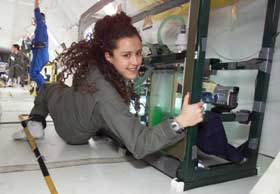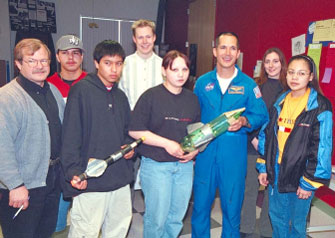

|
Mn Space Grant Consortium home page A Publication of the
|
Spring 2001Table of Contents |
VOMIT COMETCecilia Ortiz-Duenas, 21, of Mexico City, Eric Euteneuer, 21, a senior from Maple Grove, MN Chris Teeuwen, 23, a senior from Alexandria, MN, and Travis Schauer, 21, of Thorp, WI, are one of two University of Minnesota teams that won a NASA competition to conduct an experiment on board NASA’s KC-135 aircraft, known as the “Vomit Comet.” Their experiment tested how fluid acts in zero gravity. The KC-135 aircraft is used to train astronauts and it gets its colorful nickname from its nausea-inducing flight pattern: a series of parabolas during which zero gravity is achieved at the top of each curve. Here’s a look at their extraordinary experience: 
Thursday, February 8, 2001: The team of aerospace students spent the day in NASA-required flight-training at Ellington Air Force Base. There the team underwent grilling from NASA engineers about the airworthiness of their experiment. They also had just a few hours in the morning to reassemble the experiment, which had to be taken apart to be shipped to Houston. This flight training was dedicated mostly to orientation and getting experiment equipment ready for Monday’s preflight check. That’s when NASA staff can give the official OK to put the equipment on the Vomit Comet. Monday, February 12, 2001: After getting the two official OKs needed to take a trip on the KC-135 aircraft, the team spent the afternoon at the altitude simulation chamber where they learned about rapid depressurization, its one of the “worst-case scenarios” that NASA wanted them to know how to handle. To do this, they put the students in their altitude simulation chamber and take them “up,” so to speak, to 25,000 feet to experience the lack of pressure and oxygen at this altitude. Once pressure levels were lowered to that of 25,000 feet NASA staff instructed the students to take off their masks and breathe the oxygen-thin air for five minutes. Each student was given a worksheet to fill out after they had unclipped the oxygen mask. The sheet, among other things, asked them to name the most recent presidents, do simple arithmetic, complete a dot-to-dot picture and write their name. Deprived of oxygen, the students said they felt their brains begin to slow down. Two of the students laughed after putting their masks back on, both had written Al Gore as the sitting president. After training the team was fine, almost perky in fact, the “weirdness” of high altitude hadn’t dimmed their enthusiasm for the upcoming flight on the Vomit Comet. Wednesday, February 14, 2001: After a week’s worth of NASA-supervised instruction, tests and preparation, the last day of training came down to barf-bag etiquette. Crowded into a small room they listened to John Yaniec, lead test director for the KC-135, give them the straight story about the motion sickness they could expect. Vomiting is one way the body responds when the eyes and the body’s other location and sense of space detectors don’t agree. Yaniec, who flies aboard just about every trip the KC-135 makes, emphasized the NASA-approved procedure for barf bags. The official barf bag was nothing more than a regular Ziploc bag, only larger. The bag gets tucked into the upper front pocket of the flight suit issued to the students to wear during the flight. Friday, February 16, 2001: After a week of training at NASA, a 7:30 a.m. preflight meeting, putting on the NASA-issued olive green flight suits, and swallowing anti-nausea capsules, the students were ready to board the KC-135! It took about 15 minutes to get to the special flight area over the Gulf of Mexico and begin the flight pattern: about 25 seconds of float time at the top of each of the 30 parabolas the plane flies. Float-time during each parabola ended quickly and was announced by Yaniec, who yelled, “Coming down, get your feet down.” Then, macrogravity, zero G’s nasty sister, set in. Macrogravity simply refers to conditions in which the force of gravity is greater than Earth’s. Those aboard the KC-135 experienced macrogravity at the bottom of each parabola. During this time, passengers plummeted to the floor and they feel as if they weigh twice as much as they usually do. At first, the zero G was too shocking to enjoy, but weightlessness went from the theoretical to the real in a big hurry. After a few parabolas, everyone got the hang of things and thoroughly enjoyed themselves. Back at Ellington, the first question from everyone waiting there was, of course, what was it like? The students were at a loss for words. Article excerpted with permission from Jill Burcum’s Star Tribune articles: “4 U students will ride NASA’s ‘Vomit Comet’,” “Star Facing up to the challenge of the altitude chamber,” “A few pointers on barf-bag etiquette before the flight,” and “Vomit Comet: Exhilaration over Gulf of Mexico.” Affiliate News!AUGSBURG
Physics Department awarded two grants for on-going research projectsMark Engebretson, chair of the Augsburg College Physics Department, announced the award of two three-year grants from the National Science Foundation (NSF), which will support in the continuation of two of the four research projects currently being conducted at Augsburg College, each of which supports student research involvement. The first grant, a three-year, $276,000 grant from the Magnetospheric Physics branch of NSF’s Division of Atmospheric Science, supports continued operation of the Magnetometer Array for Cusp and Cleft Studies in Arctic Canada, which began in 1991. This grant also includes funds to continue Augsburg’s cooperation with scientists from the Institute for the Physics of the Earth in Moscow. At least two Russian scientists plan to visit Augsburg for an extended period next fall and winter. The second, a three-year, $412,892 grant from NSF’s Office of Polar Programs, supports continued operation of magnetometers at two sites in Antarctica and two sites in magnetically “conjugate” regions in Eastern Canada and Greenland. This is a long-standing project, for which Engebretson has been a co-investigator for more than 20 years. Beginning this year, he will be the principal investigator. As part of this project, he, along with Roger Arnoldy, professor at the University of New Hampshire and co-investigator, will travel to Greenland next summer to upgrade their instruments. Engebretson and assistant scientist Jennifer Posch, also of Augsburg, are planning to travel to Antarctica in January 2002 to make changes in their systems made necessary by the ongoing renovation of South Pole stations. 2001 Sverdrup Visiting Scientist Lecture ProgramAugsburg College is pleased to announce the 2001 Sverdrup Visiting Scientist Lecture Program, April 9 - 10, featuring Dr. Christopher P. McKay, Planetary Scientist with the Space Science Division, NASA Ames Center. This is a two day science education effort featuring formal presentations, informal conversations and lunch with Augsburg students and staff, and opportunities for the general public to hear and interact with the speaker through the Sverdrup Lecture Program. The President’s Dinner, prior to the Sverdrup Lecture, brings together Augsburg College faculty, alumni, and supporters to dialogue with the speaker and each other. 
BEMIDJI STATE UNIVERSITYJason Dahl wins HVIS 2000 Best Paper AwardJason Dahl graduated from BSU with physics, math, and geology majors, and a space studies minor. He was a 4 year fellowship awardee in space grant and went onto Brown University to continue his education. He will complete his Ph. D. at Brown within a year. In November of 2000, Jason attended the 2000 Hypervelocity Impact Symposium in Galveston, TX. At the conference, Jason presented a paper entitled “Measurement of stress wave asymmetries in hypervelocity projectile impact experiments.” This was his first full-length publication. Based upon a number of factors, including originality, difficulty of research, and significance, his paper was awarded the HVIS 2000 Best Paper Award. Jason is a great success story in Space Grant! COLLEGE OF ST. CATHERINE

MACALESTERProfessor Kim Venn Honored by President Clinton as One of the Nation’s Top Junior Faculty in Science and EngineeringKim Venn, the Clare Boothe Luce Assistant Professor of Physics and Astronomy at Macalester College, received a 2000 Presidential Early Career Award for Scientists and Engineers (PECASE) on October 24, 2000, at a White House Ceremony. The PECASE award is the highest honor bestowed by the U.S. government on outstanding scientists and engineers who are in the early stages of establishing their independent research careers. This was the fifth year of the awards. Venn was one of 20 National Science Foundation (NSF)-supported researchers to receive the honor. Nine participating federal agencies, including the NSF, shared a total of 59 PECASE awards. The Clinton Administration established the awards in 1996 to recognize some of the nation’s finest junior scientists and engineers to maintain U.S. leadership across the frontiers of scientific research. Last summer, Venn received a $391,209 grant from the NSF’s CAREER program. The funding will help launch her five-year research/education project called “CAREER: The First Stellar Abundances in Local Group Galaxies” that includes not only Venn’s research, but new courses for students and a public lecture series on astrophysics. Venn’s grant was the largest CAREER award in astronomy in the program’s seven-year history. Venn specializes in the spectroscopy of evolved stars and has been conducting groundbreaking work analyzing the chemical makeup of stars in nearby galaxies. She conducts research using some of the world’s best-known observation sites including the Cerro Tololo International Observatories in Chile and the Hubble Space Telescope. 
UNIVERSITY OF MINNESOTA4th Annual Space Science Across the Curriculum Teacher Conference
Saturday, March 10, 2001 the University of Minnesota hosted the 4th annual Space Science Across the Curriculum Teacher Conference at the Science Museum of Minnesota. The conference included presenters from : the University of Minnesota, Science CentrUM and Center for Educational Technologies, Science Museum of Minnesota, Osseo School District, Circle of Life School, NASA, and Sheridan Elementary School. In addition to these presenters was astronaut John Bennet Herrington, this year’s keynote speaker. He is a NASA Astronaut at Lyndon B. Johnson Space Center in Houston, Texas. After receiving a bachelor of science degree in applied mathematics, and a master of science degree in aeronautical engineering he was selected by NASA in April 1996 to begin training at the Johnson Space Center. Mr. Herrington has logged over 2,900 flight hours in over 30 different types of aircraft. He is currently assigned to the Flight Support Branch of the Astronaut Office where he serves as a member of the Astronaut Support Personnel team responsible for Shuttle launch preparations and post-landing operations. Science CentrUMLocated in Wesbrook Hall on the U of M campus is the Science CentrUM office. Science CentrUM was created in the 1993-1994 school year. Its creation represented the collective desire of science and education faculty to collaborate in supporting excellent science education in Minnesota. Science CentrUM draws on the unique strengths of U of M research and teaching to support, develop, and make accessible outstanding professional development opportunities in science for Minnesota K-12 educators. Science CentrUM also facilitates effective involvement of U of M science faculty in K-12 education. Currently Science CentrUM is working on: ScienceWorks! (Minneapolis Public Schools Systematic Change in Science Initiative), Evolution, Standards, and Controversy, Roosevelt Medical Magnet School, and exploring collaboration on a web site. 
Program Announcements
 |
|||
|
Last modified Friday, 09-Aug-2019 09:21:38 CDT
|